🤩AP BIO Chapter 10 - Meiosis and Sexual Life Cycles
Introduction
10.1 Offspring acquire genes from parents by inheriting chromosomes
10.2 Fertilization and meiosis alternate in sexual life cycles
10.3 Meiosis reduces the number of chromosome sets from diploid to haploid
10.4 Genetic variation produced in sexual life cycles contributes to evolution
BIG IDEAS: Meiosis followed by fertilization ensures genetic diversity in sexually reproducing organisms (Big Idea 3) and provides a genetic variation that plays a role in natural selection (Big Idea 1). This cellular process is driven by the interaction of subcellular components (Big Idea 4) and uses free energy required for the growth and reproduction of living systems (Big Idea 2).
One of the characteristics of life is the ability of organisms to ___
- reproduce their own kind
[[Heredity:[[
The transmission of traits from one generation to the next
[[Variation:[[
Differences between members of the same species
[[Genetics:[[
The scientific study of heredity and hereditary variation
^^10.1 Offspring acquire genes from parents by inheriting chromosomes^^
Each gene in an organism’s DNA exists at a specific locus on a particular chromosome
In asexual reproduction, a single parent produces genetically identical offspring by mitosis. Sexual reproduction combines genes from two parents, leading to genetically diverse offspring
[[Gene:[[
A discrete unit of hereditary information consisting of a specific nucleotide sequence in DNA (or RNA, in some viruses)
What’s DNA?
The language for writing genetic programs and the polymer of four different nucleotides
[[Gamete:[[
A haploid reproductive cell, such as an egg or sperm. Gametes unite during sexual reproduction to produce a diploid zygote
[[Somatic Cell:[[
Any cell in a multicellular organism except a sperm or egg or their precursors
Humans have ___ chromosomes in their somatic cells
- 46
Describe what makes up a chromosome
Consists of a single long DNA molecule elaborately coiled in association with various proteins and includes several hundred to a few thousand genes (each of which is a specific sequence of nucleotides within the DNA molecule)
[[Locus:[[
A specific place along the length of a chromosome where a given gene is located
[[Asexual Reproduction:[[
The generation of offspring from a single parent occurs without the fusion of gametes (by budding, division of a single cell, or division of the entire organism into two or more parts). In most cases, the offspring are genetically identical to the parent
[[Clone:[[
(1) A lineage of genetically identical individuals or cells. (2) In popular usage, an individual is genetically identical to another individual. (3) As a verb, to make one or more genetic replicas of an individual or cell.
An individual that reproduces asexually gives rise to a ___
- clone
Asexual reproduction in multicellular organisms: This relatively simple animal, a hydra, reproduces by budding. The bud, a localized mass of mitotically dividing cells, develops into a small hydra, which detaches from the parent (LM)
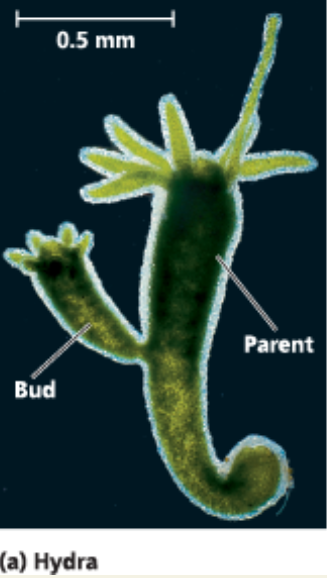
Asexual reproduction in multicellular organisms: All the trees in this circle of redwoods arose asexually from a single parent tree, whose stump is in the center of the circle
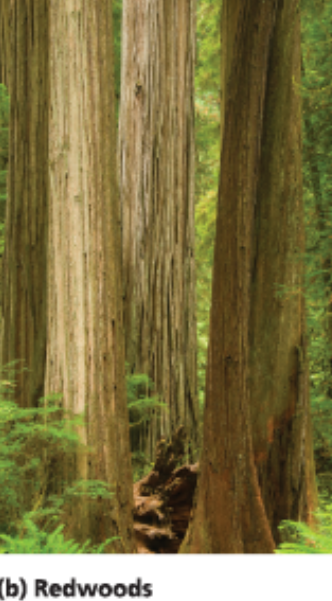
[[Sexual Reproduction:[[
A type of reproduction in which two parents give rise to offspring that have unique combinations of genes inherited from both parents via the gametes
Contrast the offspring of asexual and sexual reproduction
Offspring of sexual reproduction vary genetically from their siblings and both parents: They are variations on a common theme of family resemblance, not exact replicas
Using what you know of gene expression in a cell, explain what causes traits of parents (such as hair color) to show up in their offspring
Parents pass genes to their offspring; by dictating the production of messenger RNAs (mRNAs), the genes program cells to make specific enzymes and other proteins, whose cumulative action produces an individual’s inherited traits
How does an asexually reproducing eukaryotic organism produce offspring that are genetically identical to each other and to their parent?
Such organisms reproduce by mitosis, which generates offspring whose genomes are exact copies of the parent’s genome (in the absence of mutations)
A horticulturalist breeds orchids, trying to obtain a plant with a unique combination of desirable traits. After many years, she finally succeeds. To produce more plants like this one, should she crossbreed it with another plant or clone it? Why?
She should clone it. Crossbreeding it with another plant would generate offspring that have additional variation, which she no longer desires now that she has obtained her ideal orchid
Explain why human offspring resemble their parents but are not identical to them
Genes program specific traits, and offspring inherit their genes from each parent, accounting for similarities in their appearance to one or the other parent. Humans reproduce sexually, which ensures new combinations of genes (and thus traits) in the offspring. Consequently, the offspring are not clones of their parents (which would be the case if humans reproduced asexually)
^^10.2 Fertilization and meiosis alternate in sexual life cycles^^
Normal human somatic cells are diploid. They have 46 chromosomes made up of two sets of 23 chromosomes, one set from each parent. Human diploid cells have 22 homologous pairs of autosomes and one pair of sex chromosomes; the latter determines whether the person is female (XX) or male (XY).
*In humans, ovaries and testes produce haploid gametes by meiosis, each gamete containing a single set of 23 chromosomes (*n = 23). During fertilization, an egg and sperm unite, forming a diploid (2n** = 46) single-celled zygote, which develops into a multicellular organism by mitosis.
Sexual life cycles differ in the timing of meiosis relative to fertilization and in the point(s) of the cycle at which a multicellular organism is produced by mitosis.
[[Life Cycle:[[
The generation-to-generation sequence of stages in the reproductive history of an organism
During mitosis, the chromosomes become ___ to be visible under a light microscope
- condensed enough
[[Karyotype:[[
A display of the chromosome pairs of a cell arranged by size and shape
[[Homologous Chromosomes (or Homologs):[[
A pair of chromosomes of the same length, centromere position, and staining pattern that possess genes for the same characters at corresponding loci
One homologous chromosome is inherited from the organism’s ___ and the other from the _
- father; mother
Karyotypes are prepared from isolated somatic cells, which are treated with a drug to stimulate mitosis and then grown in culture for several days. Cells arrested when chromosomes are most highly condensed—in metaphase—are stained and then viewed with a microscope equipped with a digital camera. An image of the chromosomes is displayed on a computer monitor, and digital software is used to arrange them in pairs according to their appearance
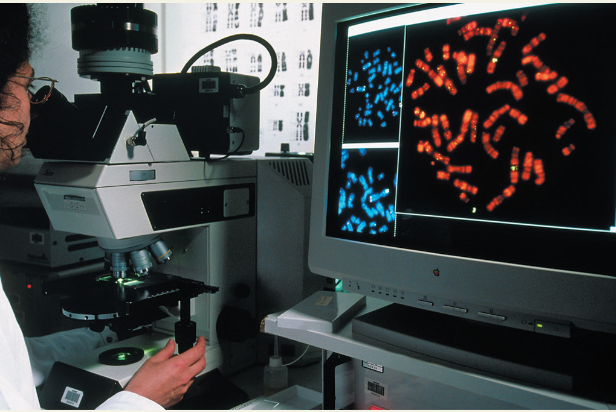
This karyotype shows the chromosomes from a human male, digitally colored to emphasize the chromosome banding patterns. The size of the chromosome, the position of the centromere, and pattern of stained bands help identify specific chromosomes. Although difficult to discern in the karyotype, each metaphase chromosome consists of two closely attached sister chromatids (see the diagram of the boxed pair of homologous duplicated chromosomes)

Human females have a homologous pair of X chromosomes (XX), but males have ___ chromosome. Only small parts of them are homologous
- one X and one Y
[[Sex Chromosome:[[
A chromosome responsible for determining the sex of an individual
[[Autosome:[[
A chromosome that is not directly involved in determining sex; not a sex chromosome
The number of chromosomes in a single set is represented by ___
- n
[[Diploid Cell:[[
A cell containing two sets of chromosomes (2n), one set inherited from each parent
What is the diploid number for humans?
46 (2 sets of 23; a maternal and paternal set)
Describing Chromosomes: A cell from an organism with a diploid number of 6 (2n = 6) is depicted here following chromosome duplication and condensation. Each of the six duplicated chromosomes consists of two sister chromatids associated closely along their lengths. Each homologous pair is composed of one chromosome from the maternal set (red) and one from the paternal set (blue). Each set is made up of three chromosomes in this example (long, medium, and short). Together, one maternal and one paternal chromatid in a pair of homologous chromosomes are called nonsister chromatids
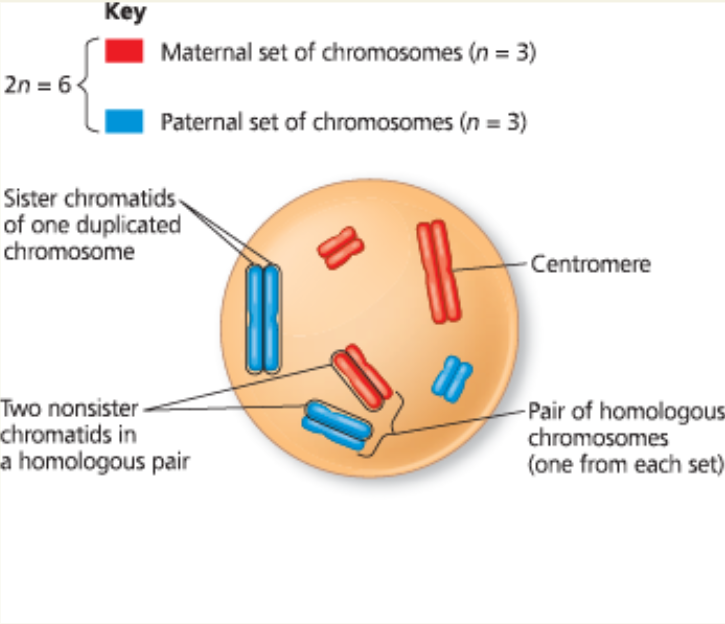
How many sets of chromosomes are present in this diagram? How many pairs of homologs are present?
Two sets of chromosomes are present. Three pairs of homologous chromosomes are present
Unlike somatic cells, gametes contain a single set of ___
- chromosomes
[[Haploid Cell:[[
A cell containing only one set of chromosomes (n)
Diploid/somatic cells have ___ the chromosomes of haploid cells/gametes
- double (2n vs n)
[[Fertilization:[[
The union of haploid gametes to produce a diploid zygote
[[Zygote:[[
The diploid cell produced by the union of haploid gametes during fertilization; a fertilized egg
Is the resulting egg of fertilization diploid or haploid?
It is diploid because it contains two haploid sets of chromosomes bearing genes representing the maternal and paternal family lines
The human life cycle: is diploid because it contains two haploid sets of chromosomes bearing genes representing the maternal and paternal family lines
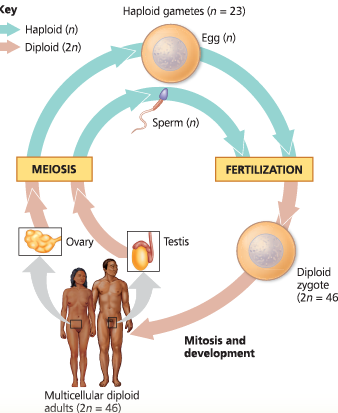
[[Germ Cells:[[
Specialized cells in the gonads (ovaries and testes) that develop gametes (the only cells not produced from mitosis)
[[Meiosis:[[
A modified type of cell division in sexually reproducing organisms consisting of two rounds of cell division but only one round of DNA replication
___ results in cells with half the number of chromosome sets as the original cell
- Meiosis
What’s the effect of fertilization and meiosis alternating in sexual life cycles?
Maintaining a constant number of chromosomes in each species from one generation to the next
Three types of sexual life cycles: The common feature of all three cycles is the alternation of meiosis and fertilization, key events that contribute to genetic variation among offspring. The cycles differ in the timing of these two key events. (Small circles are cells; large circles are organisms.)
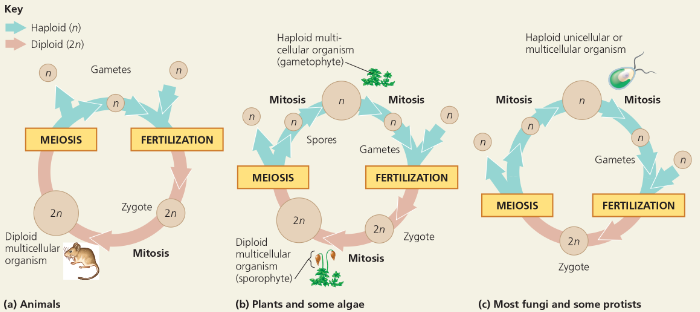
[[Alternation of Generations:[[
A life cycle in which there is both a multicellular diploid form and a multicellular haploid form; characteristic of plants and some algae
[[Sporophyte:[[
The multicellular diploid stage
[[Spores:[[
Haploid cells produced by meiosis in the sporophyte
[[Gametophyte:[[
The multicellular haploid stage generated by a haploid spore dividing mitotically
Either haploid or diploid cells can divide by mitosis, depending on the type of life cycle. Only ___ cells, however, can undergo meiosis because _ cells have a single set of chromosomes that cannot be further reduced
- diploid; haploid
In Figure 10.4, how many DNA molecules (double helices) are present (see Figure 9.5)? What is the haploid number of this cell? Is a set of chromosomes haploid or diploid?
Each of the six chromosomes is duplicated, so each contains two DNA double helices. Therefore, there are 12 DNA molecules in the cell. The haploid number, n, is 3. One set is always haploid
In the karyotype shown in Figure 10.3, how many pairs of chromosomes are present? How many sets?
There are 23 pairs of chromosomes and two sets
Each sperm of a pea plant contains seven chromosomes. What are the haploid and diploid numbers for this species?
The haploid number (n) is 7; the diploid number (2n) is 14
A certain eukaryote lives as a unicellular organism, but during environmental stress, it produces gametes. The gametes fuse, and the resulting zygote undergoes meiosis, generating new single cells. What type of organism could this be?
This organism has the life cycle shown in Figure 10.6c. Therefore, it must be a fungus or a protist, perhaps an alga
Compare the life cycles of animals and plants, mentioning their similarities and differences
Animals and plants both reproduce sexually, alternating meiosis with fertilization. Both have haploid gametes that unite to form a diploid zygote, which then goes on to divide mitotically, forming a diploid multicellular organism. In animals, haploid cells become gametes and don’t undergo mitosis, while in plants, the haploid cells resulting from meiosis undergo mitosis to form a haploid multicellular organism, the gametophyte. This organism then goes on to generate haploid gametes. (In plants such as trees, the gametophyte is quite reduced in size and not obvious to the casual observer.)
^^10.3 Meiosis reduces the number of chromosome sets from diploid to haploid^^
Meiosis I and meiosis II produce four haploid daughter cells. The number of chromosome sets is reduced from two (diploid) to one (haploid) during meiosis I.
Meiosis is distinguished from mitosis by three events of meiosis I:
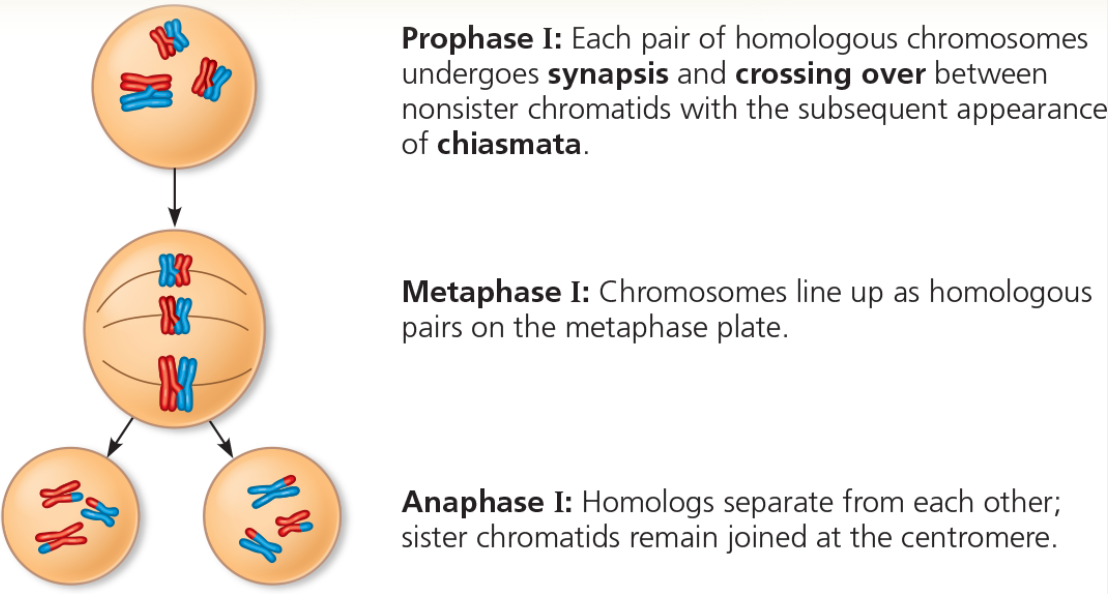
Meiosis II separates the sister chromatids
Sister chromatid cohesion and crossing over allow chiasmata to hold homologs together until anaphase I. Cohesins are cleaved along the arms at anaphase I, allowing homologs to separate, and at the centromeres in anaphase II, releasing sister chromatids
[[Meiosis I:[[
The first division of a two-stage process of cell division in sexually reproducing organisms that results in cells with half the number of chromosome sets as the original cell
[[Meiosis II:[[
The second division of a two-stage process of cell division in sexually reproducing organisms that result in cells with half the number of chromosome sets as the original cell
What do the two divisions of meiosis result in?
They result in four daughter cells, each with only half as many chromosomes as the parent cell—one set, rather than two
Compare and contrast sister chromatids and homologs
Sister chromatids are two copies of one chromosome, while the two chromosomes of a homologous pair are individual chromosomes that were inherited from different parents
Homologs appear alike in the microscope, but they may have different versions of genes at corresponding ___; each version is called an _ of that gene
- loci; allele
[[Allele:[[
Any of the alternative versions of a gene that may produce distinguishable phenotype effects
Overview of meiosis: how meiosis reduces chromosome number
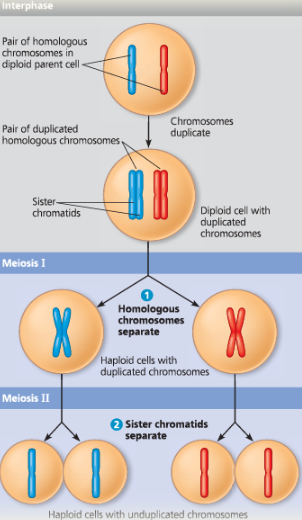
Redraw the cells in this figure using a simple double helix to represent each DNA molecule
(A short strand of DNA is shown here for simplicity, but each chromosome or chromatid contains a very long coiled and folded DNA molecule.) 
Exploring Meiosis in an Animal Cell
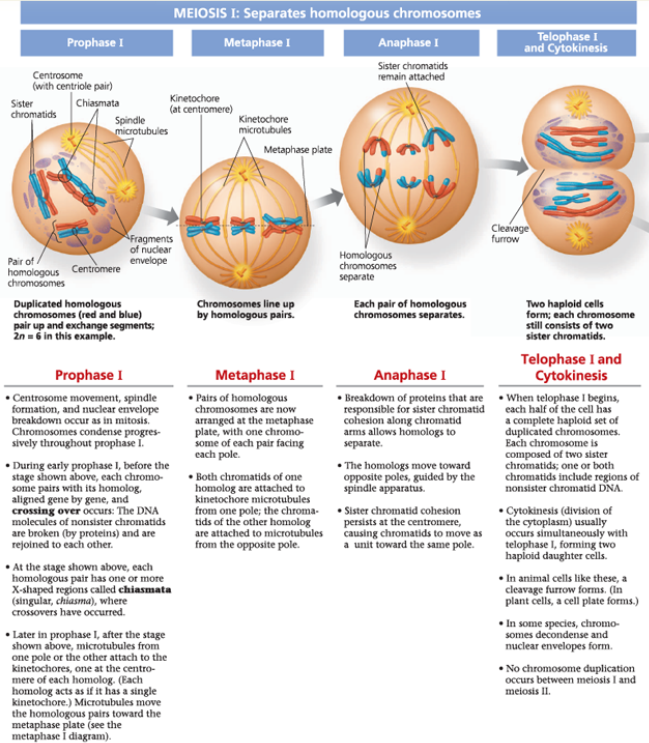

[[Crossing Over:[[
The DNA molecules of nonsister chromatids are broken (by proteins) and are rejoined to each other
[[Chiasmata:[[
A structure that forms between a pair of homologous chromosomes by crossover recombination and physically links the homologous chromosomes during meiosis
Look at Figure 9.7 and imagine the two daughter cells undergoing another round of mitosis, yielding four cells. Compare the number of chromosomes in each of those four cells, after mitosis, with the number in each cell in Figure 10.8, after meiosis. Explain how the process of meiosis results in this difference, even though meiosis also includes two cell divisions
If a cell with six chromosomes undergoes two rounds of mitosis, each of the four resulting cells will have six chromosomes, while the four cells resulting from meiosis in Figure 10.8 each have three chromosomes. In mitosis, DNA replication (and thus chromosome duplication) precedes each prophase, ensuring that daughter cells have the same number of chromosomes as the parent cell. In meiosis, in contrast, DNA replication occurs only before prophase I (not before prophase II). Thus, in two rounds of mitosis, the chromosomes duplicate twice and divide twice, while in meiosis, the chromosomes duplicate once and divide twice
Crossing over and synapsis in prophase
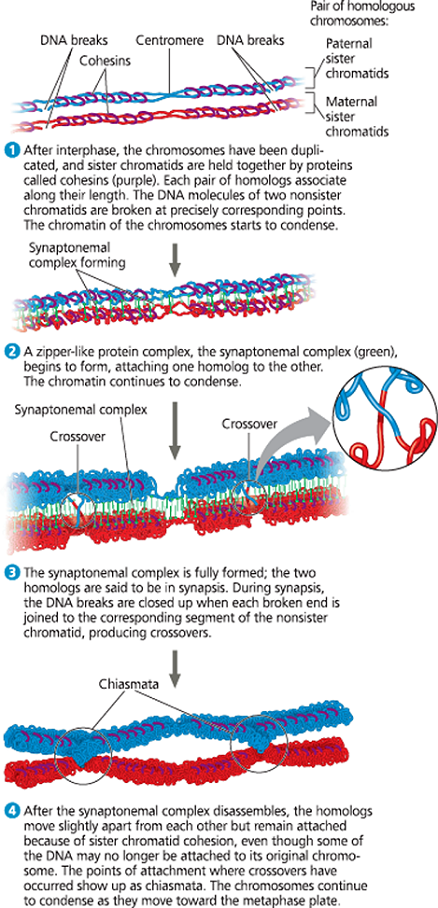
[[Synaptonemal Complex:[[
A zipper-like structure composed of proteins, which connects two homologous chromosomes tightly along their lengths during part of prophase I of meiosis
[[Synapsis:[[
The pairing and physical connection of duplicated homologous chromosomes during prophase I of meiosis
What are key differences between meiosis and mitosis in diploid cells?
Meiosis reduces the number of chromosome sets from two to one, whereas mitosis conserves the number. Meiosis produces cells that differ genetically from the parent cell and from each other, whereas mitosis produces daughter cells that are genetically identical to the parent cell
What are three events unique to meiosis occur during meiosis I?
Synapsis and crossing over, alignment of homologous pairs at the metaphase plate, and separation of homologs.
During prophase I, duplicated homologs pair up, and ___ occurs
- crossing over
At metaphase I of meiosis, pairs of homologs are positioned at the metaphase plate, rather than ___ as in metaphase of mitosis
- individual chromosomes
At anaphase I of meiosis, the duplicated chromosomes of each homologous pair move toward opposite poles, but the sister chromatids of each duplicated chromosome ___. In anaphase of mitosis, by contrast, sister chromatids _
- remain attached; seperate
Describe sister chromatid cohesion releasement
At the onset of anaphase I, the release of cohesion along sister chromatid arms allows homologs to separate. At anaphase II, the release of sister chromatid cohesion at the centromeres allows the sister chromatids to separate
A comparison of mitosis and meiosis
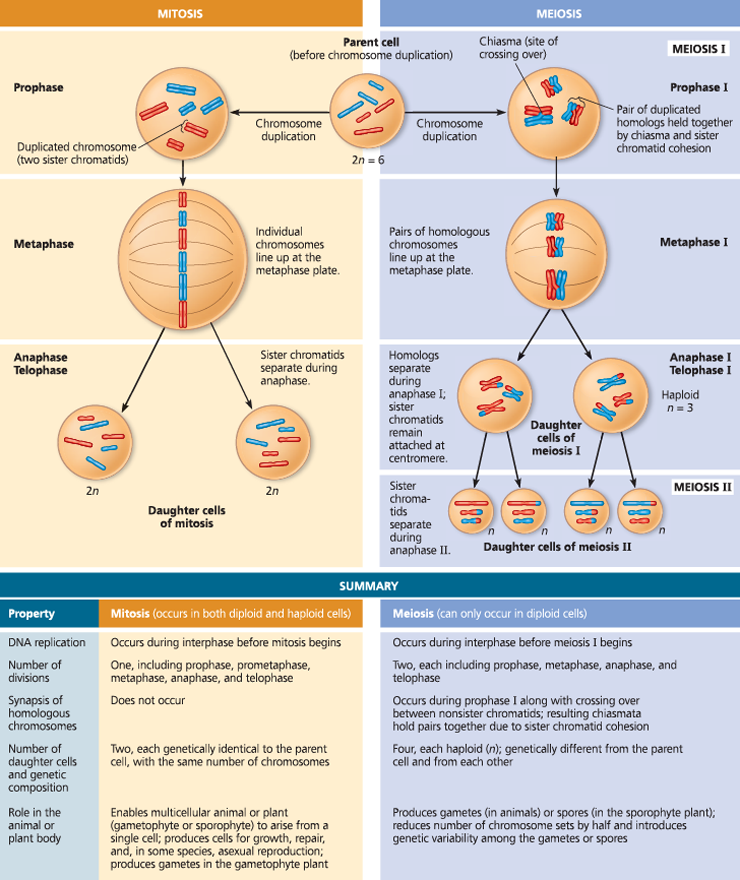
Could any other combinations of chromosomes be generated during meiosis II from the specific cells shown in telophase I? Explain. (Hint: Draw the cells as they would appear in metaphase II.)
Yes. Each of the six chromosomes (three per cell) shown in telophase I has one nonrecombinant chromatid and one recombinant chromatid. Therefore, eight possible sets of chromosomes can be generated for the cell on the left and eight for the cell on the right.
Researchers grew a culture of yeast cells in a nutrient-rich medium and then transferred the cells to a nutrient-poor medium to induce meiosis. At different times after induction, the DNA content per cell was measured in a sample of the cells, and the average DNA content per cell was recorded in femtograms (fg; 1 femtogram = 1 × 10–15 gram)
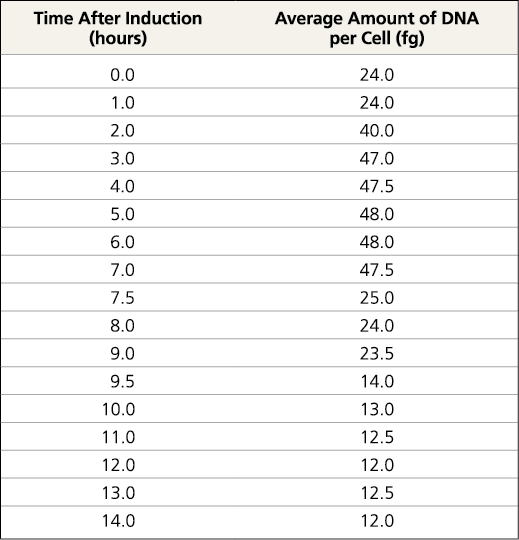
Compare the chromosomes in a cell at metaphase of mitosis with those in a cell at metaphase of meiosis II. (See Figures 9.7 and 10.8.)
The chromosomes are similar in that each is composed of two sister chromatids, and the individual chromosomes are positioned similarly at the metaphase plate. The chromosomes differ in that in a mitotically dividing cell, sister chromatids of each chromosome are genetically identical, but in a meiotically dividing cell, sister chromatids are genetically distinct because of crossing over in meiosis I. Moreover, the chromosomes in metaphase of mitosis can be a diploid set or a haploid set, but the chromosomes in metaphase of meiosis II always consist of a haploid set.
After the synaptonemal complex disappears, how would any pair of homologous chromosomes be associated if crossing over did not occur? What effect might this have on gamete formation?
If crossing over did not occur, the two homologs would not be associated in any way; each sister chromatid would be either all maternal or all paternal, and would only be attached to its sister, not to a nonsister chromatid. This might result in incorrect arrangement of homologs during metaphase I and ultimately in formation of gametes with an abnormal number of chromosomes.
In prophase I, homologous chromosomes pair up and undergo crossing over. Can this also occur during prophase II? Explain.
At the end of meiosis I, the two members of a homologous pair end up in different cells, so they cannot pair up and undergo crossing over.
^^Concept 10.4 Genetic variation produced in sexual life cycles contributes to evolution^^
Three events in sexual reproduction contribute to genetic variation in a population: independent assortment of chromosomes during meiosis, crossing over during meiosis I, and random fertilization of egg cells by sperm. During crossing over, DNA of nonsister chromatids in a homologous pair is broken and rejoined
Genetic variation is the raw material for evolution by natural selection. Mutations are the original source of this variation; recombination of variant genes generates additional diversity
The original source of genetic diversity is ___
- mutations
What three mechanisms contribute to the genetic variation arising from sexual reproduction?
Independent assortment of chromosomes, crossing over, and random fertilization
What’s the chance that a given daughter cell of meiosis I will get the maternal chromosome of a certain homologous pair or the chance that it will get the paternal chromosome?
50%
[[Law of Independent Assortment:[[
Mendel’s second law, stating that each pair of alleles segregates, or assorts, independently of each other pair during gamete formation; applies when genes for two characters are located on different pairs of homologous chromosomes or when they are far enough apart on the same chromosome to behave as though they are on different chromosomes
The number of possible combinations when chromosomes sort independently during meiosis is ___, where n is the haploid number of the organism
- 2^n
The independent assortment of homologous chromosomes in meiosis
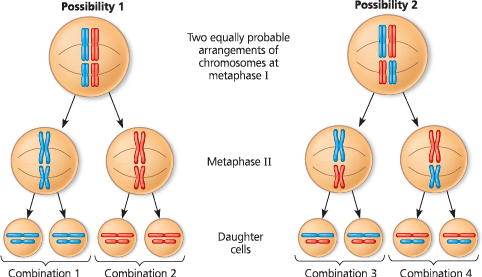
What’s a consequence of the independent assortment of chromosomes during meiosis?
Each of us produces a collection of gametes differing greatly in their combinations of the chromosomes we inherited from our two parents
Crossing over produces chromosomes with ___
- new combinations of maternal and paternal alleles
[[Recombinant Chromosome:[[
A chromosome created when crossing over combines DNA from two parents into a single chromosome
At metaphase II, chromosomes that contain ___ can be oriented in two nonequivalent ways with respect to other chromosomes because their sister chromatids are no longer identical. The possible arrangements of nonidentical sister chromatids during meiosis II increase the _ that can result from meiosis
- one or more recombinant chromatids; number of genetic types of daughter cells
The results of crossing over during meiosis
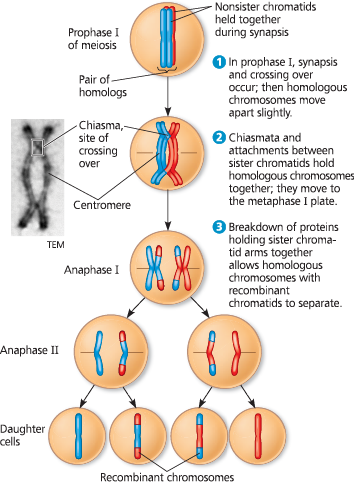
What makes fertilization random?
The fusion of a male gamete with a female gamete during fertilization will produce a zygote with any of about 70 trillion (223 × 223) diploid combinations leading to many possibilities
How does the genetic variation in a population relate to evolution?
Those best suited to the environment leave more offspring, thereby transmitting their genes. Thus, natural selection leads to an increase in genetic variations favored by the environment. As the environment changes, the population may survive if some members can cope with the new conditions. Mutations, the original source of different alleles, are mixed and matched during meiosis. New combinations of alleles may work better than those that previously prevailed.
What is the source of variation among alleles of a gene?
Mutations in a gene lead to the different versions (alleles) of that gene
If maternal and paternal chromatids have the identical two alleles for every gene, will crossing over lead to genetic variation?
If the segments of the maternal and paternal chromatids that undergo crossing over are genetically identical and thus have the same two alleles for every gene, then the recombinant chromosomes will be genetically equivalent to the parental chromosomes. Crossing over contributes to genetic variation only when it involves the rearrangement of different alleles
Explain how three processes unique to sexual reproduction generate a great deal of genetic variation
First, during independent assortment in metaphase I, each pair of homologous chromosomes lines up independent of every other pair at the metaphase plate, so a daughter cell of meiosis I randomly inherits either a maternal or paternal chromosome. Second, due to crossing over, each chromosome is not exclusively maternal or paternal, but includes regions at the ends of the chromatid from a nonsister chromatid (a chromatid of the other homolog). (The nonsister segment can also be in an internal region of the chromatid if a second crossover occurs beyond the first one before the end of the chromatid.) This provides much additional diversity in the form of new combinations of alleles. Third, random fertilization ensures even more variation, since any sperm of a large number containing many possible genetic combinations can fertilize any egg of a similarly large number of possible combinations